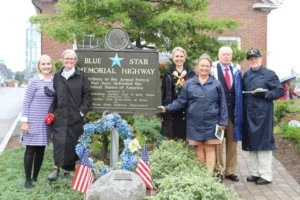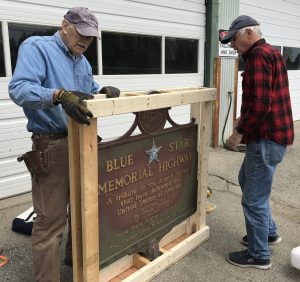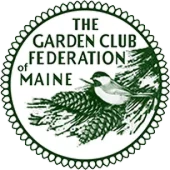Blue & Gold Star Memorial Program
Honoring our Service Men and Women
A Living Memorial Following WWII
 At the close of World War II, National Garden Clubs (called National Council of Garden Clubs at the time), like other public-spirited groups, was seeking a suitable means of honoring our service men and women. Garden Club members visualized a living memorial, preferring to help beautify and preserve the country these men and women had fought for, rather than build stone monuments in their honor.
At the close of World War II, National Garden Clubs (called National Council of Garden Clubs at the time), like other public-spirited groups, was seeking a suitable means of honoring our service men and women. Garden Club members visualized a living memorial, preferring to help beautify and preserve the country these men and women had fought for, rather than build stone monuments in their honor.
In 1944, Mrs. Lewis M. Hull, Garden Club of New Jersey President and future NCSGC President, and Mrs. Vance Hood, Roadside Chairman, had an inspired idea. One thousand flowering dogwood trees would be planted along five miles of highway, which had been designated the Blue Star Drive by the Legislature. No billboards were to be allowed on the memorial stretch. The project was named for the blue star in the service flag, which hung in windows of homes and businesses to honor service men and women.
The guest speaker at the 1945 National Council of State Garden Clubs Annual Meeting in New York City was Spencer Miller, New Jersey’s State Highway Commissioner, who had helped to implement the New Jersey project. He proposed that the program be adopted by NCSGC. At the 1945 Fall Semi-Annual Meeting, the project was approved. A “ribbon of living memorial plantings traversing every state” called The Blue Star Memorial Highway Program was adopted at the 1946 Annual Meeting in New Orleans.
In 1947, Mrs. Frederick R. Kellogg (NCSGC President 1930–1933) designed a marker, which would identify the highways. Clubs responded enthusiastically, with Rhode Island receiving the first endorsement. After official approval of the site, garden clubs would purchase markers and planting materials. Highway Departments would plant and maintain the area. This was the first program undertaken by garden clubs on a national scale.
Expansion of the Program
 While it originally began to honor World War II veterans, it enlarged its mission in 1951 to include all men and women who had served, were serving, or would serve in the armed forces of the United States.
While it originally began to honor World War II veterans, it enlarged its mission in 1951 to include all men and women who had served, were serving, or would serve in the armed forces of the United States.
The need for an extension of the program to accommodate other than dedicated highways became apparent. As a result, a smaller By-Way Marker, to be placed in areas such as parks, civic, and historical grounds, was approved at the 1981 convention in Atlanta. This marker was changed at the 1994 convention in Connecticut to be more descriptive by including the words “A Tribute to the Armed Forces of America”.
A third marker had been added at the 1996 convention in Michigan. This marker was identical to the original Blue Star Memorial Highway Marker, except for the removal of the word “Highway.” This change allowed the marker to be placed on grounds of a National Cemetery or Veterans Administration Center. At the 2004 convention in St. Louis the scope of this marker was enlarged to include other appropriate civic locations.
Gold Star Markers Support Families of Fallen Heroes
Gold Star Families is a non-profit organization created to provide support to those who have lost a loved one in service to our country through the United States Armed Forces. Their mission is to offer honor, hope and healing through remembering fallen heroes by coming together. The name Gold Star came from the custom of families of service members hanging a banner called a service flag in the window of their homes. The service flag had a star for each family member in the United States Armed Forces. Blue Stars represented living service members while a Gold Star represented those who had lost their lives. NGC clubs work with Gold Star Families to honor our fallen heroes with Gold Star Markers.
MAINE HISTORY
- 1946 GCFM adopts program.
- 1947 Route 1 designated as Maine’s Blue Star Memorial Highway. This covered 546 miles from Fort Kent to Kittery.
- 1957 U.S. Route 1 and U.S. 1-A, starting at the junction of Route 1A and 1 in Stockton Springs and extending via Bangor and Brewer to the junction of Route 1A and 1 in Ellsworth, are designated as a Blue Star Memorial Highway.
- 1972 U.S. Route 2 and State Route 3 are designated Blue Star Memorial Highways. This gave Maine 952 miles of Blue Star Memorial Highway.
- 1974 State Route 157 (Junction of 157 and 2 at Mattawamkeag to Millinocket) and State Route 201 (Junction of 1 at Brunswick to Canadian border near Jackman) is designated a Blue Star Memorial Highway, giving Maine a total of 1171.6 miles of designated highway.
- 1981 The new entrance to Maine Veterans Memorial Cemetery in Augusta is designated a Blue Star Memorial Highway.
- 2018 Gold Star Marker, P-3 Brunswick Landing, Brunswick, Maine
Guidelines for Markers
Highway Markers are placed on highways designated by the State Legislature as Blue Star Highways and require the full cooperation and approval of the State Highway Departments.
Memorial Markers are placed at National Cemeteries, Veterans’ Homes, Veterans’ Hospitals, Veterans’ Cemeteries and other civic locations. All Markers are approved by the State Blue Star Chairman, GCFM President and National Garden Club Blue Star Memorial Markers Chairman. For Maine Blue & Gold Star Memorial inquiries, contact the GCFM Blue & Gold Star Markers Chair, Linda Redman, at [email protected].
Additional information about the Blue & Gold Star Marker Program can be found on the NGC website, including pricing and order forms.

